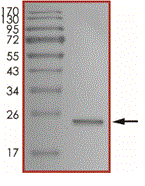
Tau-441 (216-391), Biotinylated(T08-55LNB)
FOR BULK ORDER REQUESTS PLEASE CONTACT US
Description :Recombinant human Tau-441 (216-391) was expressed in E. coli cells with an N-terminal Avi tag and biotinylated in vitro prior to the final chromatography purification.
Species :Human
Tag :AVI
Expression System:E.coli
Sequence :(216-391)
Genbank Number :P10636-8
Alternative Name(s) :Tau-F, (2N4R), Tau-4, MAPT, MSTD; PPND; DDPAC; MAPTL; MTBT1; MTBT2; FTDP-17; FLJ31424; MGC138549
Formulation :Recombinant protein stored in the buffer: 50mM Tris-HCl, pH 7.5, 150mM NaCl, 0.25mM DTT, 25% glycerol.
Storage and Stability :Store product at –70oC. For optimal storage, aliquot target into smaller quantities after centrifugation and store at recommended temperature. For most favorable performance, avoid repeated handling and multiple freeze/thaw cycles.
Scientific Background :Tau-441 or Tau-F is a member of the Tau family of proteins which function to stabilize the microtubules by binding to them. Tau proteins are subject to phosphorylation and this phenomenon regulates the association of the Tau protein with the microtubules (1). Deposits of Alzheimer's disease AD-associated proteins, such as hyperphosphorylated Tau, as well as other shared misfolded proteins, such as, -amyloid precursor protein (APP), ubiquitin, and various chaperones and protein kinases are thought to play a pathologic role in the cognitive decline and muscular failure. Malfunctioning of Tau proteins is associated with microtubules disintegration and collapsing of the neuronal transport system (2).
References :1. Zilka, N., et al. Truncated tau from sporadic Alzheimer's disease suffices to drive neurofibrillary degeneration in vivo. FEBS Lett. 2006; 508: 3582-3588.
2. Rial, A. et al: Calcium Dyshomeostasis in -Amyloid and Tau-bearing Skeletal Myotubes. J. Biol. Chem., 2004; 279: 3524-53532.
Purity :
Molecular Weight :Observed MW ~24 kDa. Calculated MW ~20 kDa.
Product Sheets (By Lot #) :
